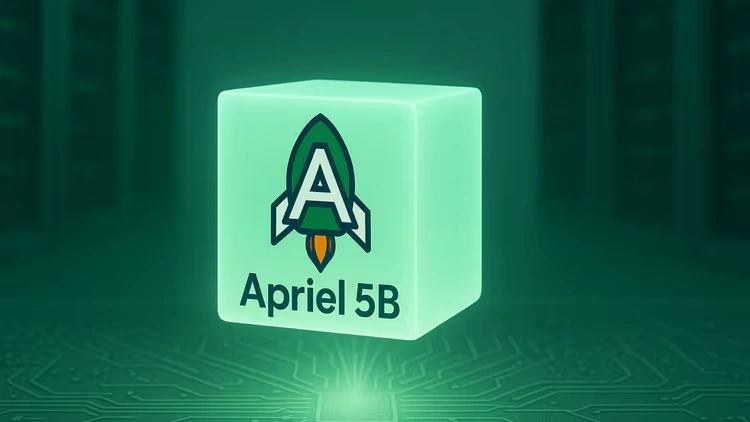
The Single-GPU Revolution: ServiceNow's Apriel-1.5-15B-Thinker Proves Bigger Isn't Always Better
ServiceNow AI's new 15-billion-parameter multimodal model achieves frontier-level performance while running on a single GPU, challenging the industry's obsession with scale.
The AI industry has been operating under a simple assumption: more parameters equals more intelligence. ServiceNow AI Research just threw that assumption out the window with Apriel-1.5-15B-Thinker, a 15-billion-parameter multimodal reasoning model that achieves frontier-level performance while running on a single GPU.
The Performance Paradox
What makes Apriel-1.5-15B-Thinker genuinely disruptive isn’t just its capabilities, it’s the efficiency with which it delivers them. The model achieves an Artificial Analysis Intelligence Index score of 52 ↗, matching DeepSeek-R1-0528 despite being 8-10 times smaller.
 The benchmark results tell a compelling story:
The benchmark results tell a compelling story:
- AIME 2025: ≈88%
- GPQA Diamond: ≈71%
- LiveCodeBench: ≈73%
- Instruction-Following Benchmark: 62%
- Tau-squared Bench (Telecom): 68%
These aren’t just respectable numbers, they’re frontier-level performance from a model that fits comfortably on consumer-grade hardware. The implications for enterprise deployment are staggering.

Mid-Training: The Secret Sauce
ServiceNow’s breakthrough comes from what they call “mid-training”, a combination of continual pretraining and supervised fine-tuning that delivers remarkable results without reinforcement learning.
The training methodology reveals a sophisticated approach to efficiency:
Depth Upscaling: Starting from Pixtral-12B-Base-2409, the team expanded the model from 40 to 48 layers through depth upscaling, avoiding the computational cost of pretraining from scratch.
Staged Continual Pretraining: The model underwent two CPT phases, first developing foundational text and vision understanding, then enhancing visual reasoning through targeted synthetic data generation.
Targeted Data Strategy: The team used synthetic augmentation to create training samples focusing on spatial structure, compositional understanding, and fine-grained perception. This approach yielded significant gains, for example, improving MathVerse (Vision Dominant) performance by +9.65 points.
The most telling detail? ServiceNow accomplished this with just 640 H100 GPUs over 7 days, a fraction of the compute budget typically allocated to frontier models.
The Single-GPU Reality
The model’s deployment story is where things get genuinely interesting. ServiceNow explicitly designed Apriel-1.5-15B-Thinker to “suit one GPU”, operating within fixed memory and latency budgets that make enterprise deployment practical.
This isn’t just about cost savings, it’s about accessibility. Organizations with privacy requirements, air-gapped environments, or budget constraints can now deploy frontier-level AI capabilities without massive infrastructure investments. The model is available on Hugging Face ↗ under the MIT license, complete with training recipes and evaluation protocols.
Multimodal Performance Without Multimodal Fine-Tuning
Perhaps the most counterintuitive aspect of Apriel-1.5-15B-Thinker is its multimodal capability. Despite undergoing text-only supervised fine-tuning, the model demonstrates competitive performance across ten image benchmarks, averaging within five points of Gemini-2.5-Flash and Claude Sonnet-3.7.
The researchers attribute this to cross-modal transfer, the model’s reasoning capabilities developed during text training effectively transfer to visual tasks. This challenges conventional wisdom that multimodal performance requires explicit multimodal fine-tuning.
What This Means for the AI Industry
ServiceNow’s achievement signals a fundamental shift in how we think about AI development:
Efficiency Over Scale: The era of throwing compute at problems might be ending. Thoughtful architecture and training strategies can deliver comparable results with dramatically reduced resources.
Democratization of AI: Frontier-level capabilities are no longer exclusive to organizations with massive GPU clusters. Apriel-1.5-15B-Thinker makes sophisticated AI accessible to startups, research institutions, and enterprises with modest infrastructure.
New Optimization Frontiers: The focus is shifting from parameter count to training efficiency. As ServiceNow’s technical lead noted in their research paper ↗, “mid-training is becoming more and more important” for achieving performance gains.
The Road Ahead
ServiceNow’s work demonstrates that we’re only scratching the surface of what’s possible with efficient AI design. The team acknowledges that while their model excels at text-based reasoning and document understanding tasks, there’s room for improvement in purely visual reasoning.
What’s clear is that the AI industry can no longer justify massive parameter counts as the only path to intelligence. As one researcher involved in the project noted, their goal was to show that “a SOTA model can be built with limited resources if you have the right data, design and solid methodology.”
Apriel-1.5-15B-Thinker isn’t just another model release, it’s a challenge to the entire AI ecosystem. If frontier performance is achievable on a single GPU, what excuses do we have left for not making AI more accessible, efficient, and practical?
The revolution won’t be televised, but it might just run on your desktop GPU.



